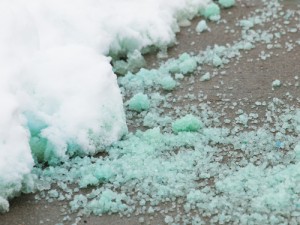It wasn’t long ago that temperatures were regularly approaching one-hundred, but before long we’ll be dealing with freezing temperatures. Since Oklahoma weather brings the possibility of ice and snow as early as October and as late as April, it’s important to be prepared well in advance. Before winter weather hits, understand how it affects your concrete surfaces and learn how to prevent damage.
- Concrete De-icer
When snow and ice melt, they turn to water, which can penetrate cracks and porous surfaces. If that water then refreezes, those surfaces can be badly damaged as chipping, flaking, spalling and pitting are created. This is a good reason to clear your driveway when winter weather hits. But, consider concrete de-icer. These products mix with the water content of snow and ice to lower their freezing point. This causes them to melt. Along the way, however, the de-icer is diluted more and more until it’s no longer effective. At this point, all that melted snow and ice refreezes. This actually increases the number of freeze/thaw cycles of the moisture and increases the amount of damage done to the concrete surface.
- De-Icing Salt
Have you heard the term “subflorescence”? It’s an important process to understand if you regularly use rock salt on your concrete surfaces. When an excess of salt is used to melt snow and ice, the extra salt can end up anywhere. It can do damage to landscaping, be tracked into your home, or, when left sitting on concrete, it can recrystalize in the pores of concrete, which results in chipping and spalling or the surface. This recrystalizing process is subflorescence. Be sure to follow directions of de-icing salt and chemicals in order to avoid these products being allowed to affect more than the ice and snow. As the snow melts, wash off the surfaces where de-icer was used to minimize damage.
- Salt corrosion
In extreme cases, chipping of the surface of concrete isn’t the only concern when using de-icing salt. If allowed to seep into cracks and reach rebar used in the concrete, this metal can rust and corrode. As rust and corrosion build, it pushes out the surrounding concrete, which ends with cracks and spalling. Additionally, as concrete is damaged and breaks down, it becomes even more susceptible to these problems with chemicals and salt.
To avoid these issues, your first step is proper installation of the concrete. High-quality concrete that is professionally installed will be much less susceptible to damage of this nature and less porous.
Using a proper sealant helps keep harmful chemicals out of concrete and preserves it for longer. Stop by Maxwell Supply of Tulsa before your next concrete project and ask us about Euco-Guard 350, a deep penetrating siloxane sealer designed to protect concrete structures, decks, pavement and surfaces against the adverse effects of de-icing salts, moisture, weathering and freeze damage. Get full protection in just one treatment.
